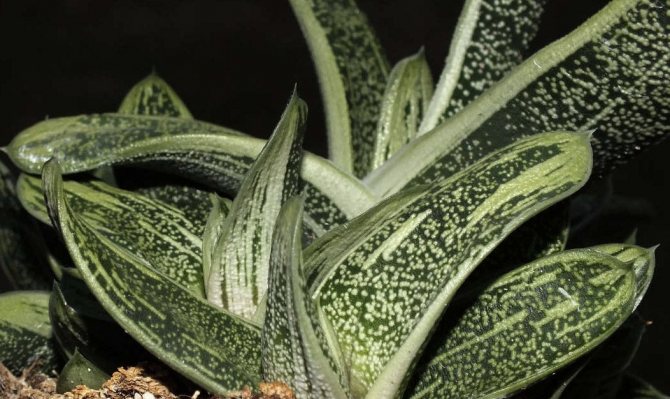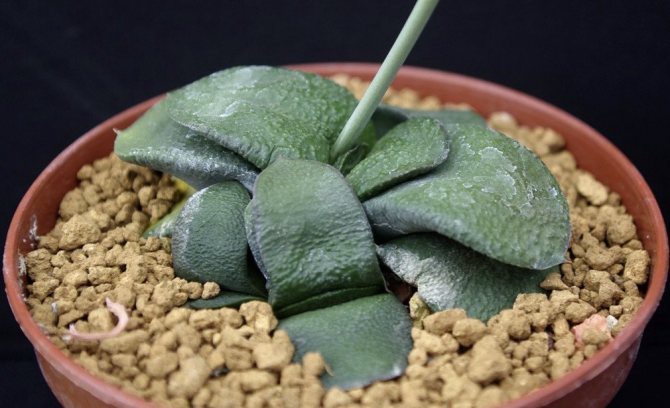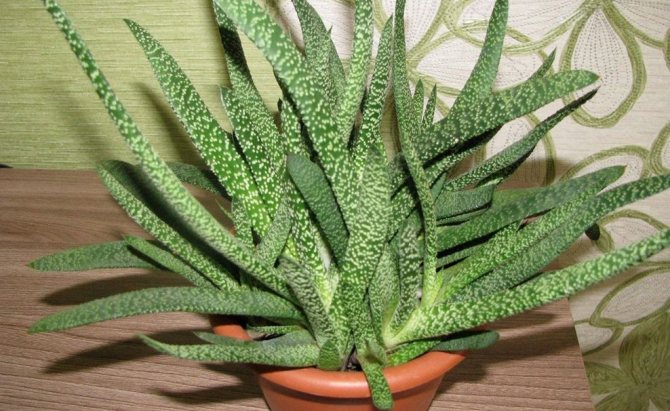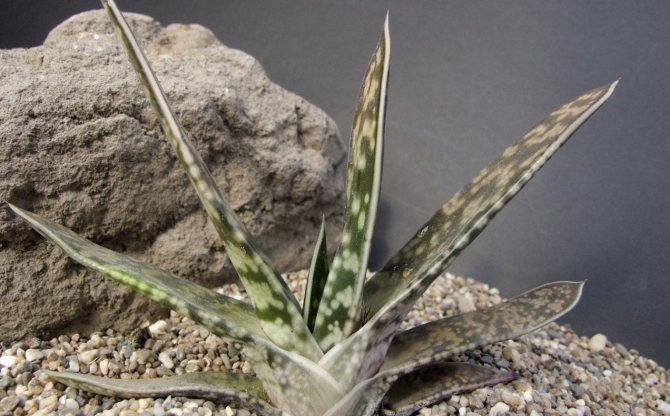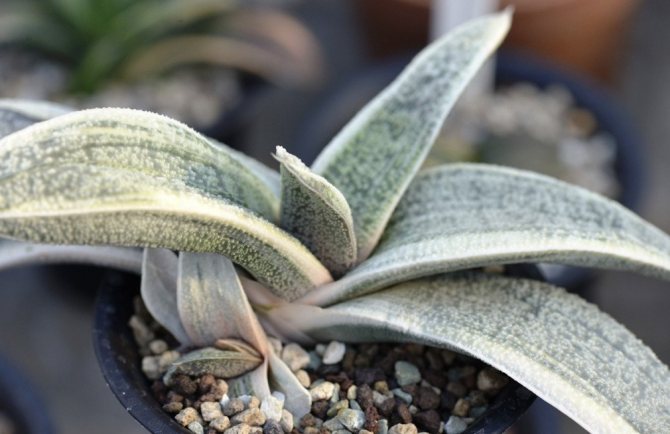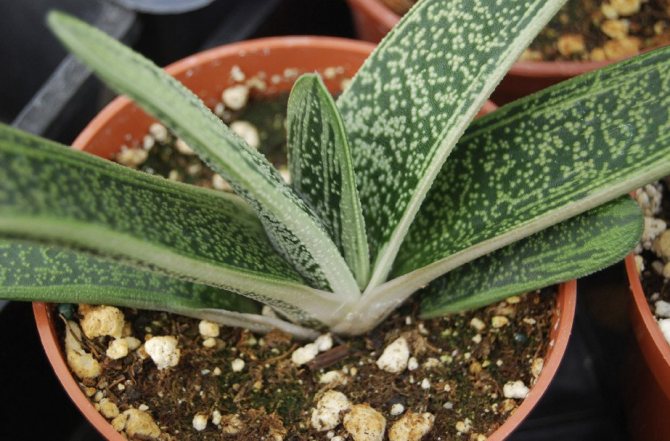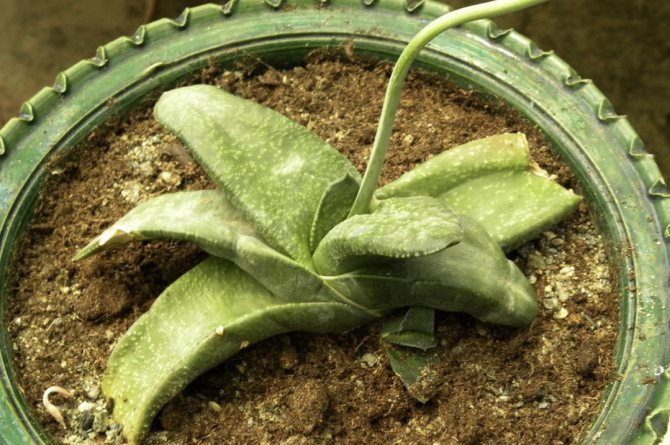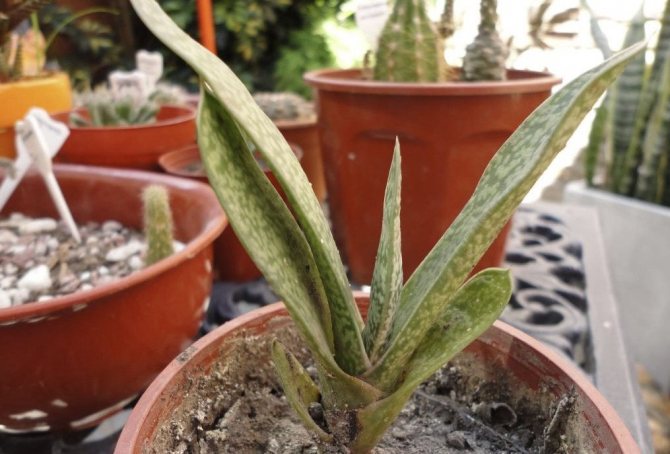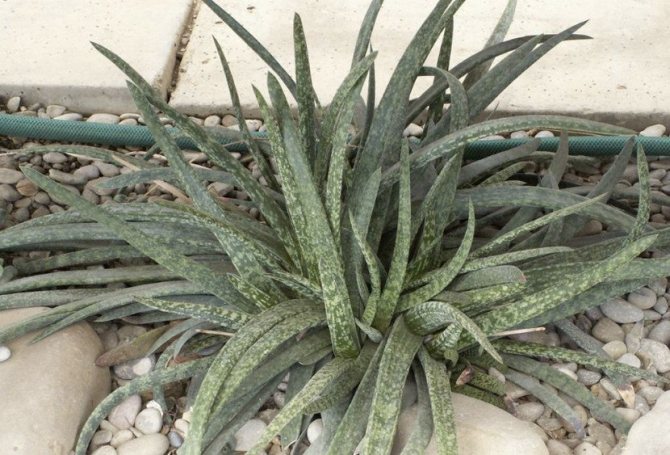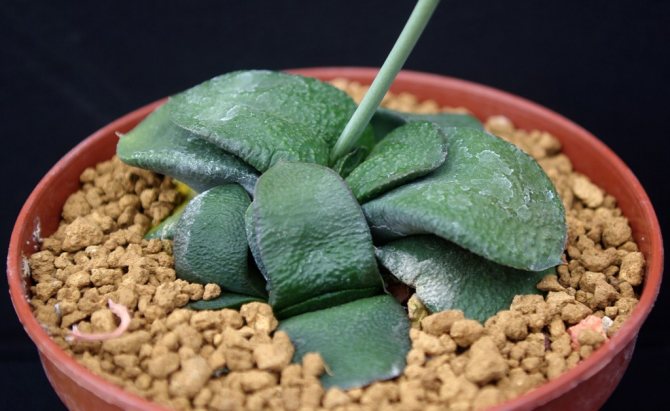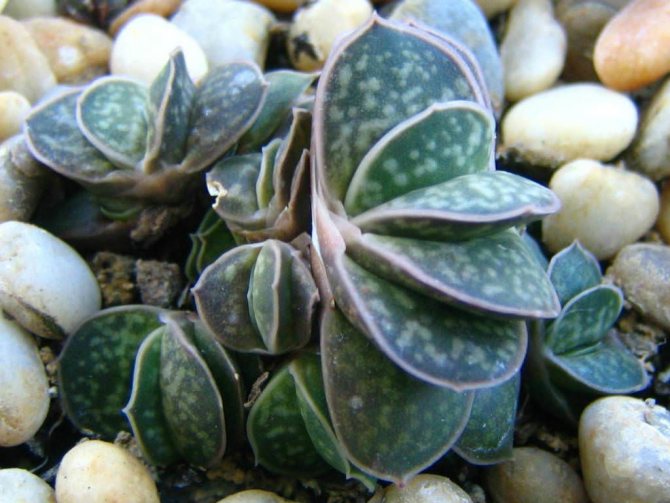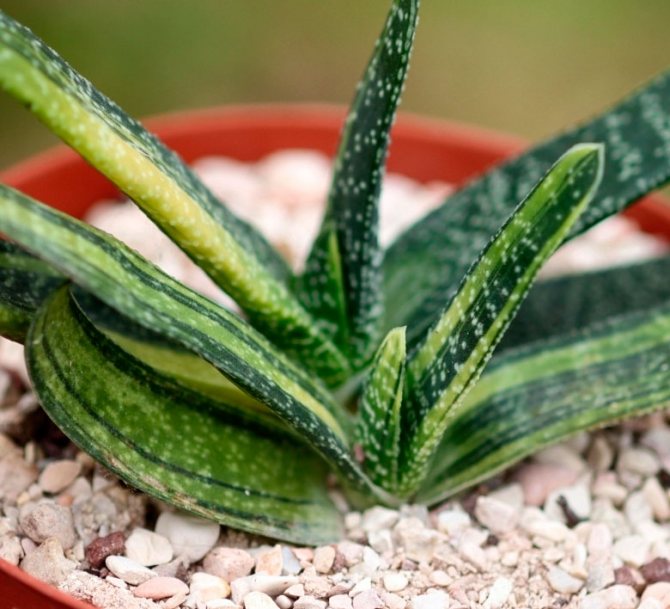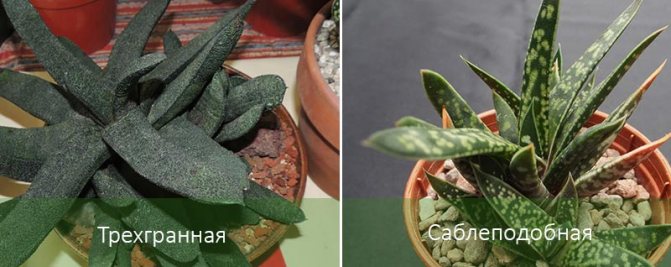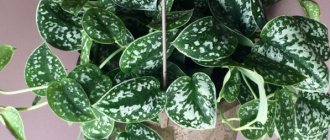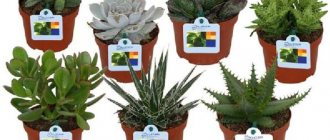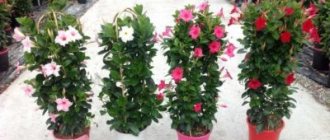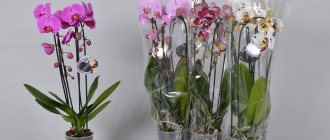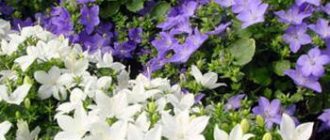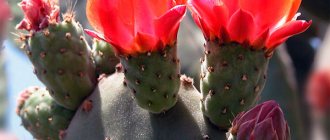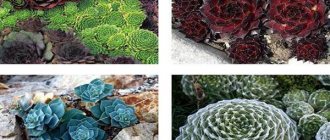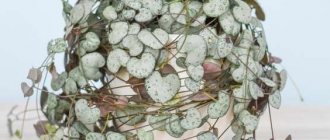Description of the plant
Gasteria - a perennial plant, belongs to the representatives of succulents. It has fleshy leaves, pointed or rounded.
Leaves the largest representatives reach a length of 35 cm. This flower grows rather slowly, unpretentious, ideal for an apartment.
She is light-requiring, does not like abundant watering.
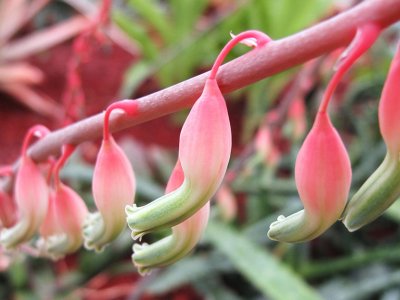
This is due to its origin. This flower is native to South Africa. In the vastness of native deserts, there are about 80 species of this flower.
Among the plants that have settled on the windowsills, you can count about 10 types of gasteria.
Leaves dark, saturated green. Some are covered with stripes and speckles.
There are leaves with small tubercles along the entire length and denticles along the edges. The leaves are arranged in two rows, in some species they unfold in a spiral.
Small flowers, having a tubular shape, swollen at the base, resemble a vessel. The petals are fused. They are yellow, red or orange.
This flower is known for absorbing carbon dioxide during the daytime, and it releases oxygen at night.
That is why this flower is placed in the bedroom.
Due to its small size, bright color and beautiful leaves, the flower Gasteria is used in various compositions... It goes very nicely with cacti.
General information about the flower
The genus Gasteria comes from South Africa, where its representatives occupy valleys, deserts, mountain slopes and other arid regions of the continent. The culture was given a beautiful and at the same time unusual name for the fact that the flowers of the latter bear a striking resemblance to a vessel like a decanter or a flask: the base of the perianth tube is the swelling. Translated from Latin, "gasitron" literally means "pot-bellied vessel".
Vegetable diet for weight loss
Gasteria belongs to the Liliaceae or Asphodelov family, but it differs sharply outwardly from most of the members of this green clan that are familiar to us. In addition to flowers that look like curved miniature bottles, which, in addition to everything, have a bright color of mainly yellow, orange and green tones with transitions, collected in "loose brush" inflorescences, the plant has juicy leaves of a tongue-shaped or triangular shape, dark green in color ... The latter are located on the central stem in a multi-row or double row, decorated with stripes. Gastria bloom continues for a month. During this period, the reproductive organs open in turn. It should be noted that as they grow older, the leaves of the exotic form first a compact and then not too neat rosette. The leaves of the plant are quite long, they can reach 25 cm. Peduncles are even more impressive: 40-70 cm tall. But the size of the reproductive organs is quite small: 2-5 cm. Cultural gasteria looks great both alone and in a flower arrangement, which is in the hands of landscape designers and simply amateur flower growers.
Views
- Gasteria Armstrong - a perennial plant with an unusual appearance. It has short, thick leaves that do not grow longer than 3 cm.
In height, the maximum can reach 10 cm. The leaves at the ends are rounded and slightly wrinkled. They are arranged in two rows, forming a fan.Blooms mainly in winter. The flowers are small and pink. 

Gasteria soddy - a plant that does not have a stem. Its leaves are arranged in transverse rows, reaching 15 cm in length and 3 cm in width.
They are deep dark green in color, have a convex shape and have greenish-white spots along their entire length. The flowers are small, about 2 cm, red or pink.- Gasteria spotted has smooth leaves, reaching a length of 22 cm, a width of about 5 cm, dark green with elongated spots.
The edges of the leaf are rough. They are dense in appearance, fleshy, slightly convex. The flower has a short stem, about 30 cm. The flowers are tubular, swollen at the base, red with a green border. - Gasteria is whitish does not have a stem. The leaves are arranged in a rosette. The lower leaves grow up to 35 cm long and 10 cm wide. They are dark green in color with white blotches and have a glossy surface.
The stem with flowers reaches 1 m. Flowers have a slightly swollen shape, reach 8 cm in length, saturated red. - Gasteria warty - perennial plant. The leaves are collected in a root outlet. They have an elongated shape, reaching 15 cm, dark green in color with small whitish tubercles - warts that give the leaf a roughness.
The inflorescence grows up to 80 cm in height. The flowers grow about 4 cm in length and are cylindrical in shape. This species has reddish flowers with a green border.
Features of flowering and dormancy of a plant
The main flowering period of Gasteria is spring and the first half of summer. The flowering period is usually at least a month. It begins with the formation of an orange inflorescence from a rosette on the stem or foliage.
Even the smallest representatives of Gasteria have tiny peduncles. They look like pot-bellied bottles, usually the main color is replaced by another less saturated one.
If care is respected, a lush bloom appears. But you need to remember that if the plant pot is located on the northern windowsill, the chances of blooming are very small. Peduncles usually appear in the spring or summer season, outwardly they resemble small bells, the shape of which is irregular.
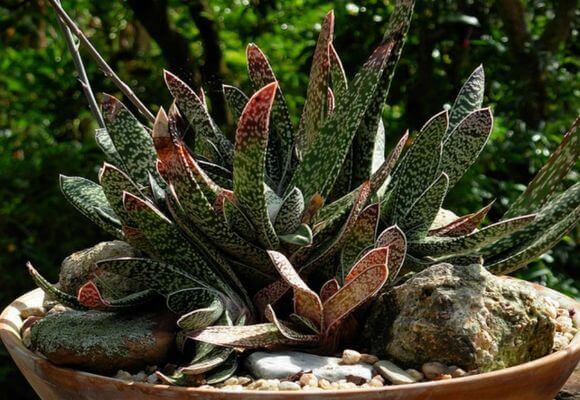

The color of the flowers ranges from pale pink to bright scarlet. Up to fifty small flowers can be located on one inflorescence.
If you want to get seed, you need to periodically shake the peduncle to get pollen on the stigma of the flower itself. When the period of active flowering continues, you should not change the location of the pot, change the temperature, lighting and basic care rules.
After the flowering period is over (this happens around the end of July and beginning of August), in the place where the peduncles were previously located, fruits appear, which are small boxes, inside them are seeds. If seed is not required, the fruit can be removed along with the rest of the inflorescence.
The dormant period of gastria continues throughout the fall and winter. Only this type of dormant period in spotted gastria falls just in the summer.
During dormancy, soil moisture should be reduced to a minimum, watering only when the soil surface dries up. Also, during the rest period, it is necessary to reduce the temperature in the room to 13 degrees. Top dressing for this time is not carried out.
Photo
Gasteria Armstrong:
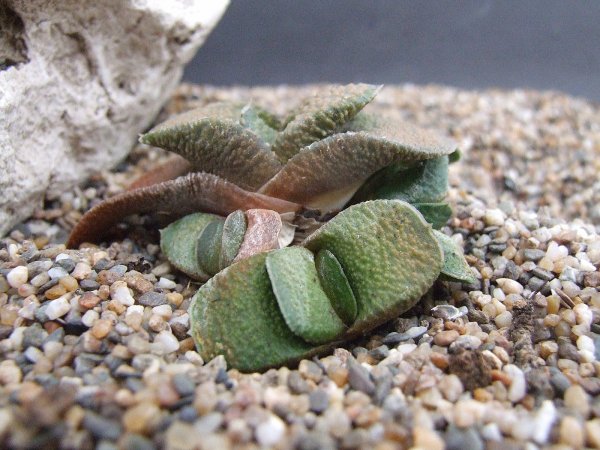

Sod Gasteria:
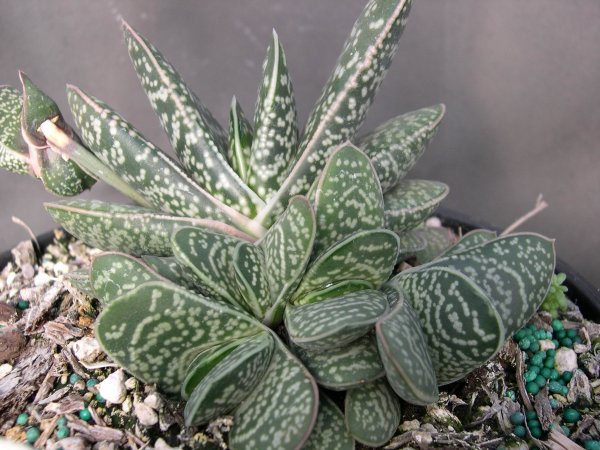

Gasteria spotted:
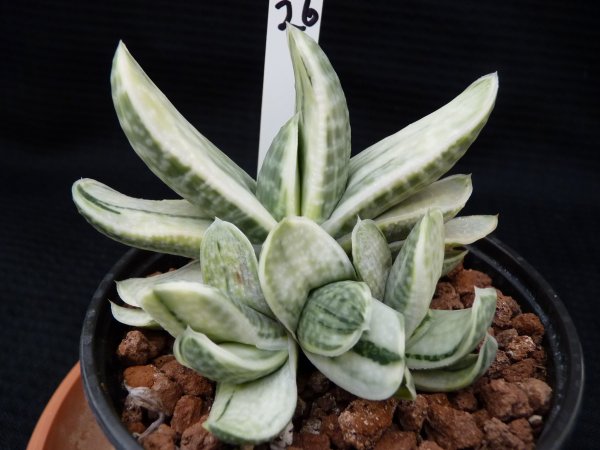

Gasteria is whitish:


Gasteria warty:
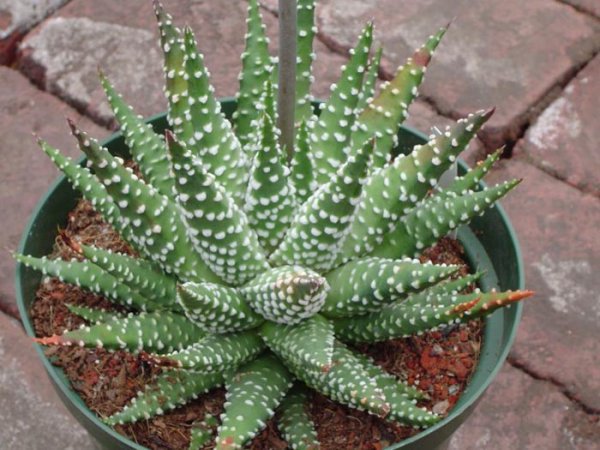

Home care
For proper home care for gastria, certain requirements must be met.
Temperature
In summer it develops well at temperatures up to 25 degrees. But in winter it will feel more comfortable at a temperature of about 15 degrees.This period is the phase of relative rest of the flower.
While maintaining high temperatures all year round are fraught with lack of flowering... This flower is afraid of drafts. Therefore, when airing the room, especially in winter, it is worth removing it from the windowsill.
Watering and humidity
Does not like abundant watering.
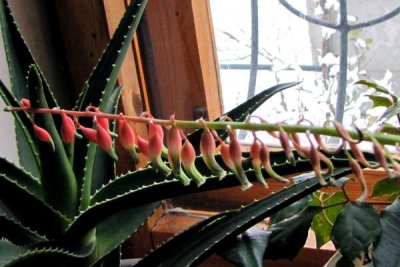

In the summer, you need to water it no more than once a week. In winter can limit yourself to watering once a month.
But if the temperature in the room is high, then you need to make sure that the soil does not dry out too much.
The flower does not require high humidityas he is originally from South Africa. Accordingly, it does not need foliage spraying. This procedure can be performed occasionally to remove dust from leaves.
Light mode
Gasteria is a light-loving plant. The most successful placement of this flower on windows facing east or west.
In the summer months, the flower is taken out into the fresh air, under a canopy, in order to avoid rainfall. In winter, the daylight hours for a flower should last 16 hours.
Transplant and soil
When transplanting it is worth choosing small pots with a small diameter. The bottom is covered with a drainage layer. Any garden soil is suitable as a substrate, while mixing in a small amount of coarse sand.
You can make a different composition of the substrate:


5 pieces of sheet;- 3 turf lands;
- 2 pieces of sand;
- 4 peat.
A small amount of brick chips is added to this mixture. You can also use ready-made cactus soil. The transplant should be carried out every two years, in the spring.
When planting in a new pot, the flower is taken out of the old with all the ground. The new pot should be slightly larger in diameter.
Top dressing
To fertilize the soil, you need to use formulations intended for cacti.... The only thing to watch out for is the dosage, which needs to be halved.
Fertilizers should be applied during the summer months. In the rest of the year, the flower does not need feeding.
Bloom
Gasteria begins to bloom in May-June.
Sometimes, in place of the flowers, fruits appear. But the flower will never bloom if it stands on the windows facing north.
Growing problems, diseases and pests
Growing a crop is pretty easy. Problems arise only from improper care of gastria:
- With an excess of water, rotting of the leaves and root system begins.
- The leaf plates become pale from lack of light.
- Severe yellowing of foliage, burns occur when exposed to sunlight.
- Reddening of the leaves occurs due to a lack of light, passes on its own.
The main pests of gasteria include spider mites, scale insects, and aphids. Preventive insecticide treatment will help prevent this.
Gasteria is a wonderful and unpretentious plant. Even a beginner can handle it. The flower does not have a negative effect, but even benefits. With proper care, the culture will delight you with abundant flowering and beautiful flowers, and a variety of varieties will allow you to choose the one that will be more pleasant at home.
Reproduction
The most convenient reproduction is the separation of daughter rosettes or rooting of cuttings... The stalk or rosette is first dried, then planted in the ground.
You can also try growing from fruits that have grown in place of flowers. Seeds are sown on moist soil and covered with foil.
Periodically you need to ventilate and spray the ground. Seeds take a long time to germinate, so be patient.
After germination, the seedlings are dived and transplanted into a suitable pot.
Common problems
It rarely gets sick. Most problems arise from improper, over-watering. The dampness of the soil makes the flower susceptible to bacteria and fungus.The only way to save a decaying plant is to cut out the affected tissue and transplant it into a new sterile substrate. The sections are sprinkled with charcoal powder. Fungicide treatment prevents the spread of infection to healthy tissue. Violation of the rules of care can lead to other problems.
| The leaves become soft, wrinkled, pale. | Excess moisture in the soil. | The soil is well dried. When the soil acidifies, they are transplanted. |
| The appearance of dry brown spots. | Insufficient watering. | They normalize the irrigation regime, do not allow the earthen coma to dry out. |
| Lack of flowering. | Keeping warm during the resting phase. | Keep the flower cool in winter. |
| Poor flowering. | Low air temperature. | The flower is rearranged to a warmer place. |
| Rotting stem. | A combination of several factors - low temperature, dampness of the soil and lack of light. | The conditions of detention are being adjusted. |
Subject to the basic conditions of keeping, the plant retains its decorative effect for a long time. In compositions, it goes well with other succulents.

